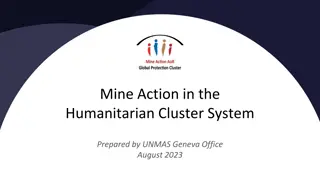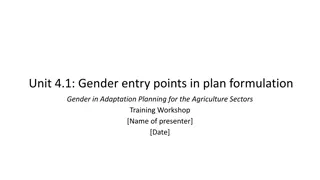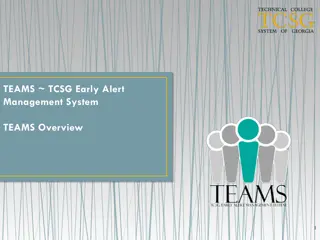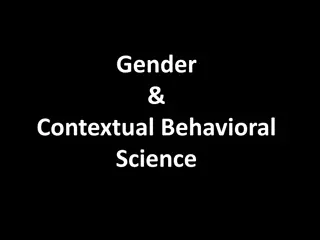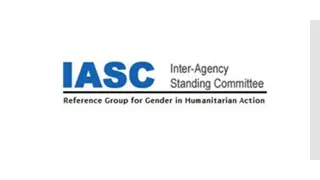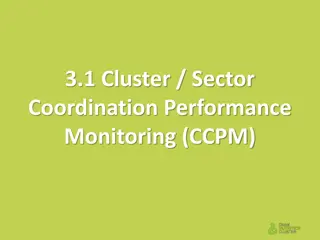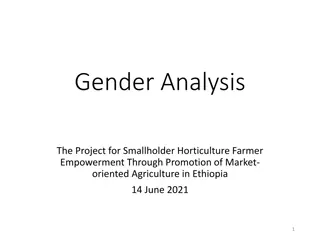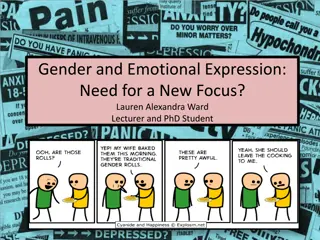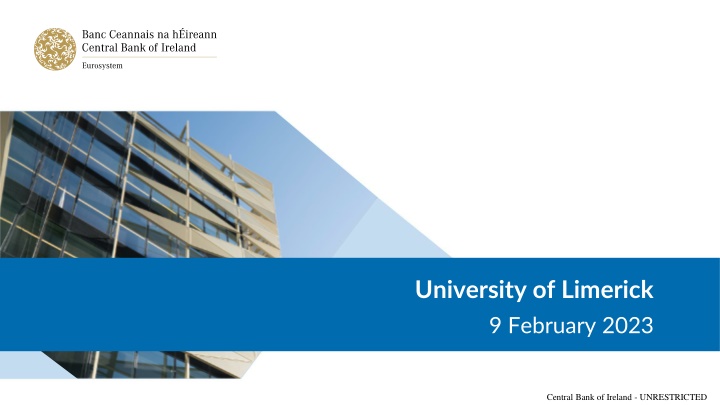
IASC COVID-19 Gender Alert - Pragmatic Guidance and Analysis
IASC COVID-19 Gender Alert provides pragmatic guidance for humanitarian stakeholders, emphasizing gender analysis and risk assessment related to COVID-19, health workers, GBV, and more. It sets minimum standards for gender integration in response plans and offers sector-specific guidance. Explore Global Rapid Gender Analysis and the importance of including women in decision-making.
Download Presentation

Please find below an Image/Link to download the presentation.
The content on the website is provided AS IS for your information and personal use only. It may not be sold, licensed, or shared on other websites without obtaining consent from the author. If you encounter any issues during the download, it is possible that the publisher has removed the file from their server.
You are allowed to download the files provided on this website for personal or commercial use, subject to the condition that they are used lawfully. All files are the property of their respective owners.
The content on the website is provided AS IS for your information and personal use only. It may not be sold, licensed, or shared on other websites without obtaining consent from the author.
E N D
Presentation Transcript
University of Limerick 9 February 2023 Central Bank of Ireland - UNRESTRICTED
2 Inflation in Ireland has reached its highest level in decades 25 20 15 10 % 5 0 -5 -10 1923 1932 1941 1950 1959 1968 1977 1986 1995 2004 2013 2022 Source: CSO, Consumer Price Index. Last obs: 2022. Central Bank of Ireland - UNRESTRICTED
3 The societal costs of high inflation Over the past year, very high inflation has eroded real incomes, dented economic confidence and led to a sharp deceleration in the economy. Aggregates also mask distributional effects. The recent inflation surge has had a disproportionately adverse impact on those with more limited means to absorb these the price increases. The rapid acceleration of inflation has been partly triggered by a real shock: the impact of very high energy prices stemming from Russia s invasion of Ukraine. If broader inflationary dynamics were to become engrained, everyone would be worse off. When the rate of inflation is high and unpredictable, it is more difficult for people to plan how much they can spend, save or invest. This harms the economy as a whole not just now, but also into the future through lower levels of investment, adversely affecting future economic potential. Central Bank of Ireland - UNRESTRICTED
4 The pandemic resulted in a demand-supply imbalance in goods Global supply chain pressures rose sharply during the pandemic and have been slow to dissipate The pandemic led to an initial tilting in spending towards goods and away from services 3,500 7,000 5.00 3,000 6,000 4.00 2,500 5,000 3.00 2,000 4,000 million million 2.00 1,500 3,000 1.00 1,000 2,000 0.00 Electrical goods Hardware (RH axis) Accommodation Restaurants (RH axis) 500 1,000 -1.00 0 0 Feb-19 May-19 Aug-19 Nov-19 Feb-20 May-20 Aug-20 Nov-20 Feb-21 May-21 Aug-21 Nov-21 Feb-22 May-22 Aug-22 Nov-22 -2.00 1998 2002 2006 2010 2014 2018 2022 Source: NY FED, Global Supply Chain Pressure Index (GSCPI) Last obs: Dec 2022. Source: Central Bank of Ireland, Credit and Debit Card Statistics. Last obs: December 2022. Note: Lines show the 12-month rolling annual sum of expenditure under each category. Central Bank of Ireland - UNRESTRICTED
5 The re-opening led to surge in demand for some services The re-opening saw a sharp increase in prices in pandemic-restricted services Re-opening saw strong pent-up demand for some services, especially hospitality and leisure activities. 9 25 Restaurants and hotels (LHS) Accommodation services (RHS) 8 20 Combined with continued pandemic-related restrictions and emerging labour shortages in those sectors, prices accelerated. 7 15 6 % Year-on-year % year-on-year 10 5 5 4 Overall, the pandemic shock resulted in sectoral imbalances between demand and supply across the economy. 0 3 -5 2 -10 1 0 2019-01 -15 Those sectoral imbalances initially drove inflation, which had already started rising in Ireland in 2021. 2020-01 2021-01 2022-01 Source: Central Bank of Ireland, internal calculations. Last obs: ??? Central Bank of Ireland - UNRESTRICTED
6 Russia s invasion of Ukraine amplified the shock Russia s invasion of Ukraine led to an unprecedented increase in gas prices The sharp increase in energy prices led to an acceleration of headline inflation 250 12 10 Wholesale gas price 200 8 Market implied path 150 6 MWh 4 100 2 50 0 -2 0 2008Q1 2009Q1 2010Q1 2011Q1 2012Q1 2013Q1 2014Q1 2015Q1 2016Q1 2017Q1 2018Q1 2019Q1 2020Q1 2021Q1 2022Q1 2023Q1 2024Q1 2025Q1 -4 1999 2003 2007 2011 2015 2019 Source:Refinitiv Eikon. Source: Eurostat. Last obs: December 2022. Central Bank of Ireland - UNRESTRICTED
7 These initial shocks have pushed up measures of underlying inflation Measures of underlying inflation increased sharply in 2022 12 Around 60% of the items in the basket of goods and services grew at a rate greater than 5% 10 Trimmed Mean Core HICP HICP All-Items 8 year-on-year % change 6 4 2 0 -2 -4 -6 Source: Eurostat, CBI calculations. Last obs: Dec 2022 Source: SDW, CBI internal calculation. Last obs: Dec 2022. Rising energy prices have spilled over into broader, domestically-generated price pressures across the economy. These underlying measures of inflation are crucial for the medium-term outlook. Central Bank of Ireland - UNRESTRICTED
8 Monetary policy has responded to bring inflation back to target In light of building inflationary pressures, monetary policy has tightened globally Market-implied real interest rates for the euro area have increased significantly over the past year 2 1 0 -1 percent -2 -3 -4 -5 Jan-22 Jan-23 -6 Source: Bloomberg & CBI internal calculation. Notes: Real rates are calculated as the difference between (nominal) swap rates and inflation swap rates Source: IMF Adrian, Natalucci. Central Bank of Ireland - UNRESTRICTED
9 The outlook for inflation Headline inflation likely to have peaked in Q4 of 2022 and should moderate as the year progresses, assuming no further unexpected shocks to energy prices. Core inflation, however, is expected to be more persistent over the course of 2023. In the current macroeconomic environment, there is substantial uncertainty around inflation projections. As we have seen in repeated upward revisions during 2022, when inflation is high, it tends to be both more unstable and more difficult to forecast. What will be the key factors that will be central to the outlook for underlying inflation in Ireland? Central Bank of Ireland - UNRESTRICTED
10 Labour market dynamics Posted wages consistent with second-round effects of initial inflation shock, with some catch up expected Very tight labour market, as evidenced by record employment, low unemployment and high vacancies 180 10% 9% 160 8% 140 Index (February 2020 = 100) Annual percentage change 7% 120 6% 100 5% 80 4% 60 3% 40 2% 20 1% 0 0% Feb-20 Apr-20 Jun-20 Aug-20 Oct-20 Dec-20 Feb-21 Apr-21 Jun-21 Aug-21 Oct-21 Dec-21 Feb-22 Apr-22 Jun-22 Aug-22 Oct-22 Dec-22 Mar-19 Jun-19 Sep-19 Dec-19 Mar-20 Jun-20 Sep-20 Dec-20 Mar-21 Jun-21 Sep-21 Dec-21 Mar-22 Jun-22 Sep-22 Dec-22 Total Job Postings (Seasonally-adjusted) Ireland US Euro Area Source: Indeed. Last obs: Jan 2023 Source: Indeed. Last obs: Dec 2022 Central Bank of Ireland - UNRESTRICTED
11 Monetary policy transmission Rising interest rates take time to transmit through to the wider economy and affect inflation. Cumulative change in new lending rates relative to cumulative change in policy rate Significant changes in structure of financial system and economy since last tightening cycle. For example: 90% 80% Ireland Euro area 70% o Greater role of non-banks in financial intermediation; 60% o Changes in structure of mortgage market, with more fixed-rate mortgages; 50% 40% 30% o Lower levels of private indebtedness, higher levels of government indebtedness; 20% 10% 0% o Evolution of monetary policy toolkit itself. Tightening cycle Nov 05 Tightening cycle May 2022 Source: SDW Do changes in interest rates still affect inflation in the same way as they would have typically done in the past? Central Bank of Ireland - UNRESTRICTED
12 Fiscal policy Tightening monetary policy is more effective at lowering inflation when it is coordinated with fiscal policy (Kloostermans et al., 2022). This is particularly relevant in a monetary union, as there may be circumstances in which the overall monetary stance may not be fully aligned to the economic conditions in every country. Public finances in Ireland improved markedly last year, although much of the improvement stems from exceptional growth in corporation tax. Structural vulnerability due to reliance on small number of companies remains. In the current environment, important that choices on the overall tax and expenditure balance avoid adding to macro-economic stimulus and, through that, medium-term inflation. Targeted and temporary supports. Central Bank of Ireland - UNRESTRICTED
13 Potential for persistent supply-side effects of shocks Beyond their near-term, cyclical effects of the pandemic and the energy crisis, shocks of this magnitude can also have a more persistent effect on the economy s potential output. For example: Labour force: In some countries, the pandemic has led to a persistent decline in labour force participation. In Ireland, labour force participation higher than before to the pandemic and this seems to be partly structural. Capital stock: High energy prices could reduce investment as well as the value of the existing capital stock, especially in the most energy-intensive sectors. Productivity: Given recent experience, companies might consider altering locations of production or transport routes. This potential shift from efficiency to resilience in supply chains could affect productivity growth. Recent shocks have shown the importance of focusing on the supply-side of the economy. Central Bank of Ireland - UNRESTRICTED
14 Summing up Inflation globally and in Ireland soared to multi-decade highs last year. It is likely that headline inflation has peaked and in the absence of further energy price shocks should moderate this year and next. But underlying inflationary pressures in the economy have built, and core inflation likely to be more persistent. And it those underlying inflationary dynamics that are particularly crucial for the medium-term outlook. The ECB has been clear that it will stay the course in raising interest rates and keeping them at sufficiently restrictive levels, to ensure timely return of inflation in the euro area to the 2% medium-term target. Fiscal policy also has an important role to play, managing a difficult balancing act between supporting those most vulnerable and not adding to inflationary dynamics. Ultimately, bringing inflation back to 2% matters for everyone, as a high and unpredictable rate of inflation has large societal costs. Central Bank of Ireland - UNRESTRICTED





